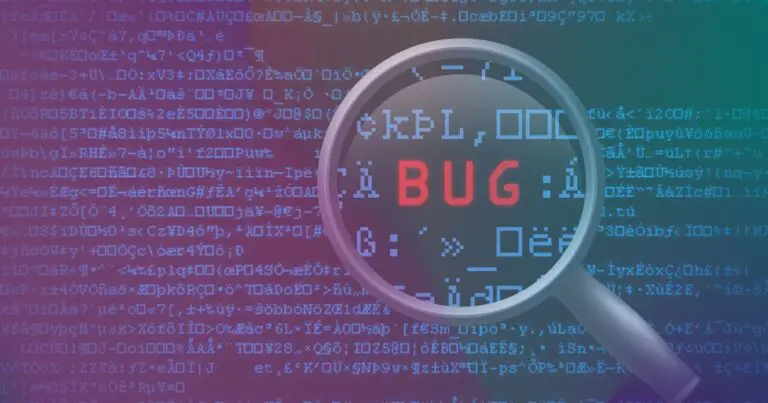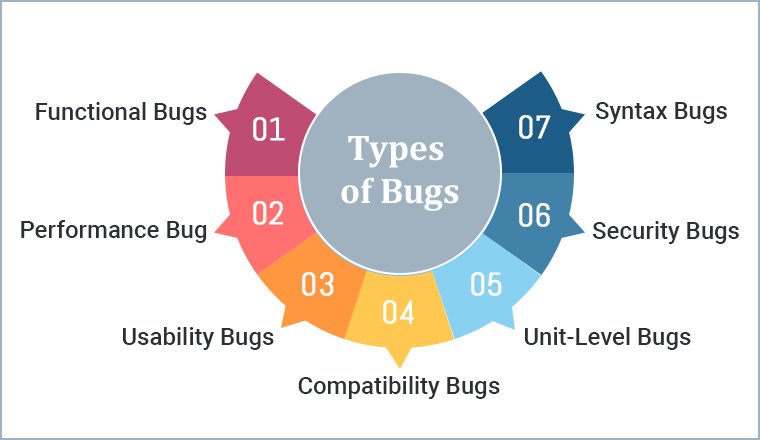
Bugs in programs are every computer programmer’s worst fear. They lie hidden in the code, waiting for their moment to destroy an unprepared machine. Knowing different types of software bugs is important for programmers who want to make their applications robust and dependable. Syntax mistakes or security loopholes—each bug has its peculiarities. So fasten your seatbelts as we dive into software troubles and unveil ten common kinds that everyone who codes should know!
Understanding the Different Types of Software Bugs

Regarding software development, bugs are inescapable entities that may penetrate the code and give rise to unexpected situations. Developers must grasp the diverse types of software bugs to identify and solve them correctly.
Syntax errors are one type of bug that occurs when code violates the rules of a programming language. Generally, such mistakes prevent a program from compiling properly.
On the other hand, runtime errors occur while a program is running and can cause crashes or unexpected behaviour.
These two kinds of insects are subtly more pernicious than their counterparts because they do not directly lead to immediate release failures but result in flawed reasoning through codes that make them run incorrectly.
Interface errors refer to issues concerning how different parts or systems interact, leading to failure in communication between components.
Calculation errors may arise from inaccuracies in mathematical operations within the code.
Memory leaks involve instances where a program cannot properly free memory, affecting its performance with time. Input/Output errors concern reading or writing data. If left unattended, security vulnerabilities could result in potential threats adversely affecting computer systems. Adverse to these various bugs is integral to ensuring stable and secure software products. Developers must be keen on testing and debugging their codes extensively before deployment. Prudent programmers who understand all this will develop high-quality solutions for their problems, hence solving more challenging problems.
Syntax Errors

Software syntax errors are like grammar mistakes. They happen when code does not comply with the rules of a programming language. Imagine writing a sentence without proper punctuation – it doesn’t make sense to the computer.
Bugs like this appear before you even run your program, and your development environment highlights them as red underlines or error messages that may look enigmatic when you first encounter them. It’s hard to read an unscrambled sentence, but there’s something wrong somewhere, which necessitates a little detective work.
Their direct association with syntax disallows program execution, making these bugs relatively easy to find and fix once detected. In other words, it is like correcting an essay after spotting a typo—fixing these mistakes is critical in ensuring your software runs smoothly without glitches.
Runtime Errors
Have you ever run a program and witnessed an error message? That’s probably a runtime error. Runtime errors occur when the software is in motion, which can cause unexpected crashes or causes of undesired behaviour.
Unlike syntax errors, Runtime errors are only detected when programs run. These bugs could result from several things, such as division by zero, accessing invalid memory locations, or type mismatching.
When dealing with runtime errors, one has to debug carefully to identify the root cause of the problem. Debuggers and logging mechanisms can help establish where the challenge is in the code. Bug fixing often entails adjusting logic flow or better handling of exceptions.
Thorough testing and proper input validation should be performed to prevent runtime errors so the software can execute smoothly without interruptions.
Logical Errors
Syntax or runtime errors often lead to program crashes, but logical mistakes in software development cannot be said to be the same. Instead, these bugs manifest as incorrect outputs due to flawed reasoning in the code.
Imagine a situation where your program compiles and runs successfully with no error messages but still gives wrong results. This might indicate a logical error within the code leading to unexpected behaviour, which is usually difficult to locate.
These bugs are usually caused by a developer’s flawed logic or false assumptions when writing the program. Effectively identifying and resolving these issues requires careful analysis and debugging skills.
Developers should address logical errors by reviewing their codes intensively, testing various cases, and checking if the output accords with their expectations according to the intended flow of logic. By being keen on details and thinking analytically and critically, programmers can reduce logical errors in their software projects.
Interface Errors
Interface bugs occur when there are problems with the conversation among various software constituents. Such slips can hamper the effective operation of the user interface, leaving users needing clarification or annoyance. One of the most common interface bugs is a button that does not behave as expected when clicked on or a link that does nothing.
Another example of an interface error is when elements on the screen overlap or appear distorted, adversely affecting the application’s visual appearance. These disparities make it difficult for people to navigate any piece of computer software, impeding its effectiveness. Additionally, developers must test their applications across different platforms due to compatibility issues between devices or browsers, which may lead to interface errors.
Developers can improve usability and increase user satisfaction by quickly correcting and fixing these errors and ensuring smooth communication between different software components.
Memory Leaks
Have you ever seen water slowly leaking from a tinny hole in the bucket without awareness? In software parlance, memory leaks happen when a program does not free up allocated memory after usage. Unused memory will keep piling up over time, which can cause the system to crash or slow down significantly.
Think of your computer as a workspace with many tasks running simultaneously, each needing some resources. Resource hogging is what memory leaks precisely do. When combined over time, performance degrades, and user experience suffers. It takes careful monitoring and analysis of how the program handles its memory space to detect such bugs.
Adequate testing should be done before releasing these programs for usage so that no stones are left unturned regarding memory leaks. By fixing these cunning bugs as soon as possible, developers can ensure high fidelity and enhanced performance of their software applications.
Input/Output Errors
Input/Output errors are comparable to breakdowns of the communication link between software and external facilities. For example, suppose you want to read a file, but it’s damaged or non-existent; this will be an I/O Error. Also, they may occur when data is being written—for instance, when transferring materials to the printer, which suddenly goes offline.
The cause of these bugs is often related to the hardware itself or user actions that are not anticipated. For example, unplugging a device while still attached to the program can throw everything out of gear. Can you imagine removing your USB flash drive without ejecting it properly? That hurts!
Detecting those errors might require full-scale testing under different modes and conditions to ensure smooth data inflow and outflow from/to the system. These issues are resolved by addressing compatibility problems, checking input validity, and gracefully handling exceptions within code.
In other words, Input/Output Errors hinder harmonious interaction between software and devices, making their resolution intricate.
Security Vulnerabilities
Users and organizations can be affected to a great extent by software security threats. When errors occur, hackers can exploit system vulnerabilities that may lead to data loss, unauthorized access or other breaches.
Buffer overflow is one of the commonly known security exposures. It entails pumping more data into a program memory buffer used for execution such that it can run any code an intruder wants without restrictions.
The other major issue is the lack of input validation that permits attackers to inject malicious scripts or commands into the application.
Insecure configurations and poor authorization procedures also contribute to this insecurity. Software developers must conduct comprehensive testing and undertake regular security audits to identify and fix these weaknesses before criminals exploit them.
Importance of Identifying and Fixing Bugs
Detecting and correcting errors is vital to ensuring that application software functions smoothly. Mistakes may result in breakdowns, crashes, and security loopholes, leading to loss of user data or even spoiling one’s experience. By settling these matters as soon as possible, general performance can be improved, and user satisfaction boosted.
Inefficiently addressing bugs can lead to financial losses and a bad reputation for an organization through faulty software developers. Furthermore, fixing bugs helps create a seamless user experience, making customers return more often.
Again, by identifying and repairing errors early, developers save time and resources that would otherwise be used to troubleshoot difficult problems at later stages. Additionally, it cultivates a quality assurance culture within development teams that will help improve software reliability over time.
This also means prioritizing bug identification and fixing, crucial in developing high-quality software products that meet users’ expectations without undermining system integrity.
Tips for Finding and Fixing Bugs
Software developers find and fix bugs, which can be challenging but rewarding. One suggestion is to perform extensive testing of the code by running different test cases to detect possible problems.
Another helpful strategy is debugging tools, which accurately pinpoint where the bug occurs in a program, making it easier to solve. Also, discussing with colleagues or consulting more experienced programmers can bring new perspectives on tackling and resolving complex bugs.
Updating your software dependencies and libraries regularly can help avoid compatibility issues that may result in bugs. Furthermore, documenting known problems and their solutions may save time when similar challenges arise.
By being organized, keeping track of changes made to the codebase and having clear communication within your team, you will simplify the process of finding and fixing errors efficiently.
AQs
- What are syntax errors in types of software bugs?
- Answer: Syntax errors occur when code violates programming language rules, preventing compilation.
- How do runtime errors differ from syntax errors in types of software bugs?
- Answer: Runtime errors occur during program execution, causing crashes or unexpected behaviour, unlike syntax errors detected during compilation.
- What are logical errors in types of software bugs?
- Answer: Logical errors produce incorrect outputs due to flawed reasoning in the code despite the program running successfully.
- What are interface errors, and how do they affect the types of software bugs?
- Answer: Interface errors occur in interactions between software components or users, causing issues like non-functional buttons or distorted displays.
- What is a memory leak in types of software bugs?
- Answer: A memory leak happens when a program doesn’t release unused memory, leading to performance degradation over time.
- What are input/output (I/O) errors in types of software bugs?
- Answer: I/O errors involve problems reading or writing data to external resources, such as a missing file or offline printer.
- What are security vulnerabilities in types of software bugs?
- Answer: Security vulnerabilities are weaknesses that attackers can exploit, such as buffer overflows and poor input validation.
- Why is fixing types of software bugs important?
- Answer: Fixing bugs ensures smooth software function, improves performance, boosts user satisfaction, and protects security.
- How can developers find and fix types of software bugs effectively?
- Answer: Developers should use extensive testing, debugging tools, and peer reviews to keep software dependencies updated.
- How can memory leaks in types of software bugs be detected and resolved?
- Answer: Memory leaks can be detected with profiling tools and resolved by ensuring proper memory deallocation in the code.
Conclusion
To make software valuable and dependable, software developers must understand the different types of software bugs involved. Discovering and eliminating mistakes in syntax, runtime, logic, interface, calculation errors, memory leaks, input/output problems, and security risks will enable them to draft better-quality programs.
In addition, it is essential at this stage to note that debugging is an ongoing process in developing software. Make good use of debugging tools for your code. Please test it out thoroughly before involving others from the team.
Throughout the development process, programmers should focus on identifying and solving bugs delivering high-quality, user-friendly, and highly efficient products. Diversify your knowledge about different types of software bugs glitches to become a skilled programmer who generates robust applications.

